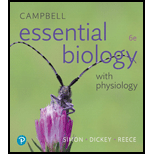
While walking in the woods, you encounter an unfamiliar flowering plant. Which of the following plant features would help you determine plant is a
- a. size of the plant
- b. number of seed leaves
- c. shape of its root system
- d. number of petals in its flowers
- e. arrangement of vascular bundles In Its stem
- f. whether or not it produces seed-bearing cones
To examine: Which plant features would help to determine whether that plant is a monocot or a eudicot.
Introduction: Angiosperms are that plants that have flowers and produce seeds that are enclosed within a carpel. The plants can be classified on the basis of structural difference into monocots and eudicots. The name of the embryonic structure of seed leaves is called cotyledons. A monocot has one seed leaf, whereas a eudicot has two seed leaves.
Answer to Problem 1SQ
Correct answer:
Option b. is given as “number of seed leaves”.
Option c. is given as “shape of the root system”.
Option d. is given as “number of petals in its flowers”.
Option e. is given as “arrangement of vascular bundles in its stem”.
Therefore, options b., option c., option d., and option e. are correct.
Explanation of Solution
Reasons for the correct statement:
Monocot has one cotyledon, fibrous root, flowers multiple of three, and vascular bundles are arranged complexly.
Eudicot has two cotyledons, taproot system, flowers usually multiple of four or five, and vascular bundles are arranged in a ring.
Hence, option b., option c., option d., and option e. are correct.
Reasons for the incorrect statement:
Option a. is given as “size of the plant”, but both monocot and eudicot have different sizes of plants. Hence, this cannot be used to differentiate between them.
So, option a. is incorrect.
Option f. is given as “whether or not it produces seed-bearing cones”, but seed-bearing cone is not a feature of monocot or eudicot.
So, option b. is incorrect.
Hence, options a. and f. are incorrect.
Want to see more full solutions like this?
Chapter 28 Solutions
Campbell Essential Biology with Physiology (6th Edition)
Additional Science Textbook Solutions
Chemistry
Applications and Investigations in Earth Science (9th Edition)
Genetics: From Genes to Genomes
Campbell Essential Biology (7th Edition)
- What is behavioral adaptarrow_forward22. Which of the following mutant proteins is expected to have a dominant negative effect when over- expressed in normal cells? a. mutant PI3-kinase that lacks the SH2 domain but retains the kinase function b. mutant Grb2 protein that cannot bind to RTK c. mutant RTK that lacks the extracellular domain d. mutant PDK that has the PH domain but lost the kinase function e. all of the abovearrow_forwardWhat is the label ?arrow_forward
- Can you described the image? Can you explain the question as well their answer and how to get to an answer to an problem like this?arrow_forwardglg 112 mid unit assignment Identifying melting processesarrow_forwardGive only the mode of inheritance consistent with all three pedigrees and only two reasons that support this, nothing more, (it shouldn't take too long)arrow_forward
- Oarrow_forwardDescribe the principle of homeostasis.arrow_forwardExplain how the hormones of the glands listed below travel around the body to target organs and tissues : Pituitary gland Hypothalamus Thyroid Parathyroid Adrenal Pineal Pancreas(islets of langerhans) Gonads (testes and ovaries) Placentaarrow_forward

 Biology (MindTap Course List)BiologyISBN:9781337392938Author:Eldra Solomon, Charles Martin, Diana W. Martin, Linda R. BergPublisher:Cengage Learning
Biology (MindTap Course List)BiologyISBN:9781337392938Author:Eldra Solomon, Charles Martin, Diana W. Martin, Linda R. BergPublisher:Cengage Learning Concepts of BiologyBiologyISBN:9781938168116Author:Samantha Fowler, Rebecca Roush, James WisePublisher:OpenStax College
Concepts of BiologyBiologyISBN:9781938168116Author:Samantha Fowler, Rebecca Roush, James WisePublisher:OpenStax College Biology 2eBiologyISBN:9781947172517Author:Matthew Douglas, Jung Choi, Mary Ann ClarkPublisher:OpenStax
Biology 2eBiologyISBN:9781947172517Author:Matthew Douglas, Jung Choi, Mary Ann ClarkPublisher:OpenStax Biology: The Dynamic Science (MindTap Course List)BiologyISBN:9781305389892Author:Peter J. Russell, Paul E. Hertz, Beverly McMillanPublisher:Cengage Learning
Biology: The Dynamic Science (MindTap Course List)BiologyISBN:9781305389892Author:Peter J. Russell, Paul E. Hertz, Beverly McMillanPublisher:Cengage Learning





